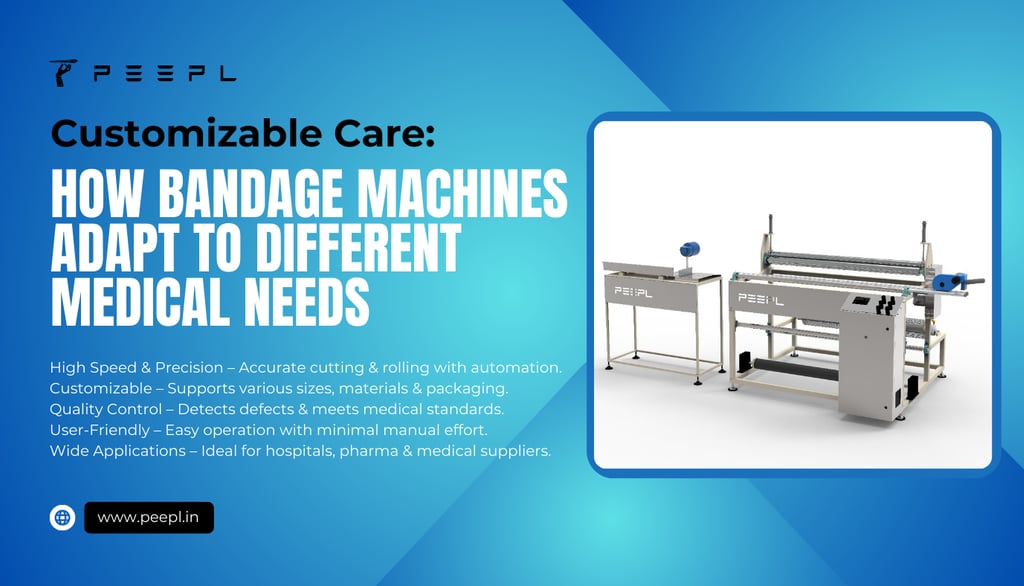Customizable Care: How Bandage Machines Adapt to Different Medical Needs
2/7/20254 min read


In the fast-paced world of healthcare, efficiency and precision are paramount. One of the unsung heroes in this domain is the bandage rolling and cutting machine, a device that has revolutionized the way medical supplies are produced. These machines are not just about automation; they are about customization, ensuring that healthcare providers have access to bandages tailored to specific medical needs. Let’s explore how these machines adapt to diverse requirements and play a critical role in modern healthcare.
High Speed, High Accuracy: PEEPL’s Cutting-Edge Solution
PEEPL’s Automatic Bandage Rolling and Cutting Machine is a state-of-the-art industrial solution designed to streamline the manufacturing and packaging of bandages and medical tape products. This innovative machine offers precision, efficiency, and consistency throughout the production process. It is capable of handling various types of bandages, from standard wound dressings to specialized medical tapes, ensuring a high level of customization and adaptability.
Key Features of PEEPL’s Bandage Machine:
Automated Operation: Operates with minimal human intervention, reducing labor costs and minimizing errors while continuously rolling, cutting, and packaging bandages.
Precision Cutting: Advanced cutting technology ensures accurate and consistent bandage lengths, which is crucial for medical applications.
Customization: Easily configurable to accommodate different bandage sizes, materials, and packaging requirements.
Quality Control: Built-in mechanisms detect and eliminate defects or irregularities during production, ensuring high product reliability.
High Throughput: Designed for high-speed operation, making it ideal for mass production in the medical supply industry.
User-Friendly Interface: An intuitive control panel allows for seamless operation and adjustments.
Hygiene and Safety Compliance: Meets stringent medical industry regulations for safe and sterile bandage production.
The Need for Customization in Bandage Production
Bandages are not one-size-fits-all. Different medical situations demand different types of bandages—varying in size, material, absorbency, and sterility. For instance:
Hospitals require sterile, pre-cut bandages for surgical procedures.
First aid kits need compact, rolled bandages for quick application.
Chronic wound care calls for specialized materials like hydrocolloid or alginate bandages.
Pediatric care requires smaller, softer bandages designed for delicate skin.
Traditional manual methods of bandage production struggle to meet these diverse demands efficiently. This is where automated bandage rolling and cutting machines step in, offering unparalleled flexibility and precision.
How Bandage Machines Adapt to Different Needs
Modern bandage machines are designed with customization at their core. Here’s how they adapt to various medical requirements:
1. Adjustable Sizing
Machines can be programmed to produce bandages in various sizes, from small adhesive strips to large wound dressings.
For example, switching from 2-inch-wide bandages to 6-inch-wide ones is seamless with minimal adjustments.
2. Material Versatility
Capable of handling cotton, gauze, non-woven fabrics, and even advanced materials like silicone or hydrogel.
Ensures the right material is used for absorbency, breathability, or adhesion needs.
3. Sterile and Non-Sterile Options
Equipped with sterilization features for clinical and surgical bandages.
Non-sterile bandages can be produced with minimal machine reconfiguration.
4. Custom Shapes and Cuts
Beyond standard rectangular bandages, machines can create circular pads, butterfly strips, and perforated designs for easy application.
5. Speed and Scalability
Suitable for small clinics needing a few hundred bandages or large hospitals requiring thousands without compromising quality.
Applications of PEEPL’s Bandage Machine
The versatility of this machine makes it an ideal choice for multiple sectors, including:
✔ Medical and Healthcare Industry – Hospitals, clinics, and first aid centers benefit from consistent and high-quality bandage production.
✔ Pharmaceutical Manufacturing – Enables the production of specialized wound care products.
✔ Medical Supply Manufacturers – Ideal for large-scale bandage production and packaging.
✔ Research and Development – Facilitates the testing of new bandage materials and designs.
✔ Veterinary Care – Provides customized wound care solutions for animals.
✔ Specialized Bandages – Supports the production of hydrocolloid, alginate, and advanced wound care products.
✔ Custom Packaging – Can be configured for specific branding and packaging needs.
The Role of Automation in Customization
Automation is the backbone of these machines’ adaptability. Features like computerized controls, sensors, and programmable settings enable operators to switch between different bandage specifications seamlessly. For instance:
A hospital can program the machine to produce a batch of sterile, large-sized gauze bandages for post-surgical care.
A first aid manufacturer can quickly switch to producing small, adhesive bandages for consumer use.
This level of automation ensures precision, reduces waste, and improves efficiency in medical production.
Benefits of Customizable Bandage Machines
The ability to adapt to different medical needs offers several advantages:
✅ Improved Patient Care – Ensures patients receive the most appropriate wound care for faster healing.
✅ Cost Efficiency – Reduces waste and optimizes supply chains for healthcare providers.
✅ Versatility – A single machine can cater to hospitals, clinics, and first aid providers.
✅ Innovation – Easily updated to incorporate the latest advancements in wound care technology.
The Future of Bandage Machines
The future of bandage rolling and cutting machines lies in smart technology and sustainability. Innovations such as AI-driven quality control, IoT-enabled monitoring, and eco-friendly materials will enhance efficiency and adaptability.
Sustainable materials like biodegradable fabrics could reduce the environmental impact of medical waste.
Conclusion
PEEPL’s Automatic Bandage Rolling and Cutting Machine is more than just an automation tool—it’s a game-changer in customizable care. By adapting to different medical needs, this high-speed, high-precision machine ensures that healthcare providers have access to the right bandages at the right time.
As technology continues to evolve, PEEPL is committed to driving innovation, making healthcare more efficient, effective, and patient-centered. Whether it's a small adhesive strip for a scraped knee or a sterile gauze pad for a surgical wound, bandage machines are proving that customization is the key to better care.
